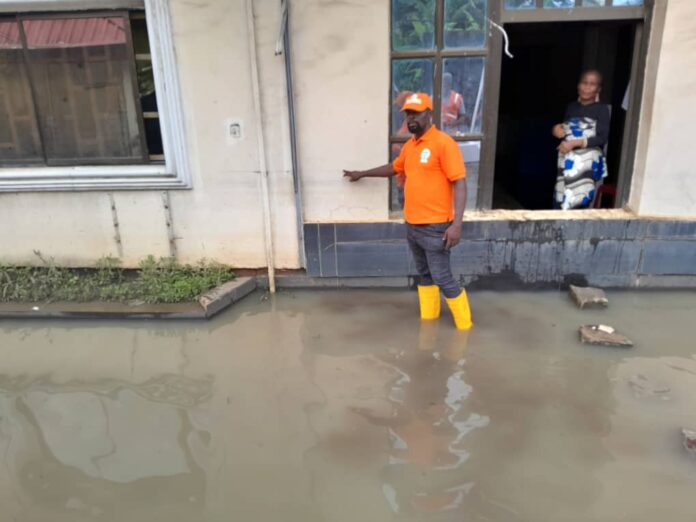The Federal Government has issued a warning of heavy rainfall across 22 states and the Federal Capital Territory (FCT), predicting possible flooding in several areas between Monday, October 14, 2024, and Friday, October 18, 2024.
This alert, released by the National Flood Early Warning Systems Centre under the Federal Ministry of Environment, calls for communities in flood-prone areas to prepare for significant water-level rises and, if necessary, evacuate to avoid severe flooding impacts.
The report identifies several states where heavy rainfall is expected to pose a high risk of flooding. These states include Osun, Delta, Cross River, Anambra, Taraba, Nasarawa, Kebbi, Gombe, Katsina, Borno, Kaduna, Niger, Yobe, Adamawa, Kogi, Kwara, Bauchi, Plateau, and Zamfara. The Federal Capital Territory (FCT) is also included in this forecast.
Communities living along the Rivers Donga, Benue, and Ogun have been particularly advised to evacuate as the rising water levels in these rivers are expected to overflow their banks. Residents are urged to take precautionary measures to safeguard their lives and property.
In Osun State, areas like Ede, Ile-Ife, Ilesa, and Osogbo are identified as being at risk, while in Delta State, Escravos is considered a high-risk zone for flooding.
Heavy Rainfall Expected in Taraba, Nasarawa, and Kebbi States
Taraba State is expected to bear the brunt of the heavy downpours, with flood risks identified in several communities, including Donga, Ibi, Wukari, Mutum Biyu, and Lau. The National Flood Early Warning Systems Centre has flagged these areas for urgent evacuation if needed.
In Nasarawa State, the town of Rukubi has been listed as one of the areas likely to experience severe flooding. Similarly, in Kebbi State, popular towns such as Argungu, Birnin Kebbi, and Gwandu are also at risk.
In the FCT, areas such as Kubwa, Gwagwalada, and Bwari are expected to be affected by heavy rainfalls that could lead to flooding, particularly in low-lying areas and those close to rivers and streams.
Gombe State’s Bajoga and Katsina State’s Bakori and Funtua are also listed as flood-prone zones during this period. Additionally, in Borno State, communities such as Biu and Briyel are at risk of experiencing flooding as the rains intensify.
The Federal Ministry of Environment has urged residents of these areas to take urgent precautions, including clearing drainage channels, relocating to safer grounds, and keeping up to date with weather forecasts.
“People living along the flood plains of Rivers Donga, Benue, and Ogun are advised to move to higher grounds to avoid being trapped by the rising water levels,” the National Flood Early Warning Systems Centre stated in its release.
The agency further emphasized that immediate action is needed to prevent loss of lives and property.
The Federal Government has been working to mitigate the effects of flooding across the country, especially with the rising occurrence of extreme weather patterns due to climate change.
The government has implemented several measures to reduce the impact of flooding, such as clearing drainages, creating flood response teams, and investing in early warning systems.
However, many experts argue that despite these efforts, infrastructure challenges, particularly in urban areas, make it difficult to manage the volume of water from heavy rainfall.
In a recent interview, a climate expert, Dr. Sani Musa, explained that “Nigerian cities and towns are often unprepared for the intensity of rainfalls. Our drainage systems are outdated, and with rapid urbanization, we are seeing more areas flood with even less rainfall.”
Dr. Musa called for a stronger response from local governments, urging them to work closely with communities to implement long-term flood management strategies.
Flooding has become a recurring problem in Nigeria, with thousands of people displaced every year. According to the National Emergency Management Agency (NEMA), more than 1.4 million Nigerians were affected by floods in 2022, with hundreds of communities submerged under water.
In addition to the immediate threat to lives, flooding in Nigeria often leads to the destruction of farmlands, houses, roads, and other critical infrastructure. This has long-term economic impacts, especially in rural areas where agriculture is the primary source of livelihood.
Experts fear that if the upcoming five days of heavy rainfall are not properly managed, many communities could face similar devastation.
An official of the Nigeria Hydrological Services Agency (NIHSA) warned that “without proper drainage and flood channels, heavy rainfalls in these states could lead to severe disruptions in the lives of Nigerians, particularly in the agricultural sector.”
The agricultural areas listed, including parts of Taraba, Adamawa, and Kogi states, are especially vulnerable as they produce a significant amount of Nigeria’s food. Floods during harvest season could lead to crop losses, food shortages, and an increase in food prices.
The 2022 floods, which were considered some of the worst in Nigeria’s history, highlighted the need for improved infrastructure and proactive measures to manage flood risks. States like Kogi and Niger were badly affected, with entire villages washed away.
This year, the government has focused more on early warnings and public awareness to prevent a repeat of such disasters.
NEMA has been working closely with local governments and community leaders to prepare people for potential evacuation and safety measures. In several high-risk areas, relief camps have been set up in anticipation of flooding, where displaced residents can seek temporary shelter.

